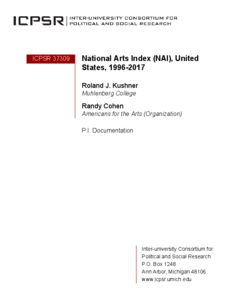
The National Arts Index is a highly-distilled annual measure of the health and vitality of arts in the U.S. using 76 national-level indicators of arts and culture activity. This report covers an 11-year period, from 1998 to 2008. This National Arts Index encompasses one of the largest collections of data on arts and culture in the U.S. ever assembled. The information has been gathered from reputable government and private sector sources and covering multiple industries—nonprofit and for-profit arts organizations, artists, funding and investment, employment, attendance and personal creation, and much more.
Readers can compare the 76 indicators and draw their own conclusions about the state of the arts, but as a comparative measure we have averaged all 76 indicators, which gives us a single number we can compare from year to year. As a baseline, we chose the year 2003 and set it at the number 100. The 2008 National Arts Index score is 98.4, a decline of 4.2 points from its 2007 score of 102.6 (2003=100). A score of 105.5 would return the Index to its highest point, measured in 1999. In addition to a single summary score, we can track many themes and trends:
- The arts follow the business cycle. The arts respond to the booms and busts of the nation’s economy. Based on past patterns, we estimate that an arts rebound will begin in 2011.
- Demand for the arts lags supply. Between 1998 and 2008, there was a steady increase in the number of artists, arts organizations, and arts-related employment. Nonprofit arts organizations alone grew in number from 73,000 to 104,000 during this span of time. That one out of three failed to achieve a balanced budget even during the strongest economic years of this decade suggests that sustaining this capacity is a growing challenge, and these gains are at risk. Introduction i 2009
- How the public participates in and consumes the arts is expanding. Tens of millions of people attend concerts, plays, opera, and museum exhibitions, yet the percentage of the U.S. population attending these arts events is shrinking, and the decline is noticeable. On the increase, however, is the percentage of the American public personally creating art (e.g., music making, and drawing). Technology is changing how Americans experience the arts and consumption via technology and social media is also up.
- The competitiveness of the arts is slipping. The arts, in many ways, are not stacking up well against other uses of audience members’ time, donor and funder commitment, or spending when compared to non-arts sectors.
Many of us have experienced the realities these figures indicate. Only now, however, do we have the research to underscore our observations on a national scale, to track if conditions improve or worsen, and gauge the effectiveness of remedial efforts designed to strengthen the arts. We will publish Index updates every October, during the annual National Arts and Humanities Month
Source: Report Introduction

